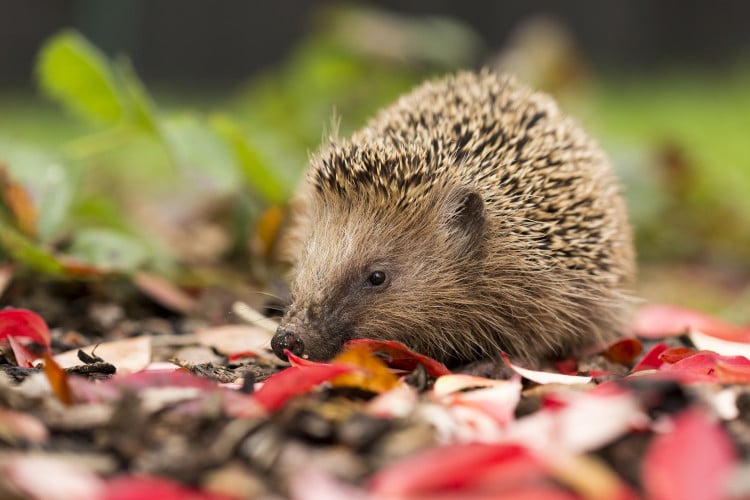At this time of year, I like to pay special attention to hibernators like hedgehogs.
I work closely with the British Hedgehog Preservation Society as an ambassador for the amazing work they do to protect and preserve these amazing little animals and there’s a lot you can do at home too!
Humble hedgehogs
A treasured part of our UK heritage, hedgehogs have a lot to offer. What’s great about these caring creatures is that they work in harmony with the delicate balance in the garden.
They’re truly the gardener’s friend, eating a myriad of garden pests like slugs, snails and caterpillars that, if left to multiply, can wreak havoc to your garden plants.
Sadly, recent findings suggest that the number of hedgehogs in the UK has fallen by more than half since 2000. Although the decline has slowed in recent years, it’s believed it is due to urbanisation of gardens which reduces hedgerows and important habitats as well as insect prey.
Luckily, there’s a lot that gardeners can do to help convert their garden into a hedgehog-friendly one and here’s how:
Access is everything
Make your garden accessible. As you may have gathered from their rather telling name, hedges are the perfect haunt for hedgehogs. This is because it provides a cover, a habitat for insect prey and also allows them to hop from garden to garden.
If your garden has a fenced boundary, don’t fret, you can easily help hedgehogs out by adding a ‘highway’. This is a CD-sized cut out for them to use as a doorway. As hedgehogs have such poor eyesight and rely on their hearing, it stops them from getting muddled and wandering into the road.
Label their new entranceway with a proudly placed ‘hedgehog highway’ sign and you might find your neighbours join in the effort to make their garden into a hedgehog haven. Find more information from the BHPS campaign, Hedgehog Street, which gives tips for keeping green spaces suitable for these marvellous mammals.

Habitat facts

Once you’ve created a way for them to get in, you’ll want these prickly pals to keep coming back.
The easiest way to keep hedgehogs happy is to provide them with a safe space. Nowadays you can easily build your own hedgehog house of an afternoon.
You can visit my website, daviddomoney.com, for instructive videos or blogs on how to do this but, essentially, the idea is to use an old wooden crate with a suitably sized entrance tunnel of 15cm wide and 11cm high, to ensure predators can’t get in.
Leaving areas of your garden to grow wild or building a log pile is also really effective for keeping your garden a safe space for these incredible creatures.
Food favourites
A single hedgehog can travel up to 2km in a night to find food, so why not open your very own hedgehog café—they’ll certainly put in the legwork to find it.
Most people don’t know that hedgehogs are actually lactose-intolerant, so although they’ll eat dairy products it causes them stomach discomfort and should be avoided. Chicken or turkey-based cat food is ideal, and you should buy the ones in jelly instead of gravy so that it’s not too salty and dehydrating.
Hedgehogs will feast and fatten themselves up before going into hibernation in November, so this is when they’re most on the search for food.
Make sure that the food supply is reaching them instead of the neighbourhood cat. Hedgehog feeding stations are sized specifically to let hedgehogs access the food source and they also keep the food covered and out of the rain—so everyone wins. Don’t forget, of course, to provide an ample water supply. Water sources can be hard found, especially in the winter, so I always put out a shallow water bowl that’s an inch or two deep and keep this topped up and refreshed daily.

Safety first

At this time of year, it’s vital to keep checking for hedgehogs in piles of leaves or garden vegetation you intend to burn on the bonfire.
Avoid building your bonfire until the last possible moment and do a thorough check of it before lighting by lifting sections with a broom handle and listening for their snuffle sounds. When the time comes to light it up, light one side first to allow them to escape out the other side if they need to.
Take the time to safety-proof your garden: cover drains and holes and discard of any netting, twine, string or elastic which might ensnare and injure them.
With ponds, I place a plank of wood into the water and staple bamboo canes across it horizontally for the hedgehogs to grip onto when climbing out.
Hedgehogs have been around for over 15-million years and they’re a truly Britain’s most incredible mammals, so keep them safe and not only will they keep your garden growing but, together, we may be able to keep them thriving for another 15 million!
Happy hibernating everyone!
Tip:
Leave some herbaceous perennials
to create a winter habitat for your
garden’s wildlife.
Reader questions
How do I prepare my asparagus beds for spring?

While spring is still far away, November is a great time of year to prepare asparagus for the following season. Firstly, cut back any dried fern stalks and remove any weeds lurking in the bed. Then add a rich manure or fertiliser with equal parts of lime, rock phosphate or bone meal. Finally, apply an organic mulch and on completion, your asparagus will be all ready for the coming spring.
What trees are winter-flowering?

Prunus subhirtella is sometimes marked as the autumn or winter cherry.
Its flowers start to open in the late autumn, but its flowering peak is reached in the early following spring. Else, winter-flowering cherry ‘Autumnalis Rosea’ has pale pink flowers the unfurl during mild weather from late autumn to early spring.

Leave A Comment